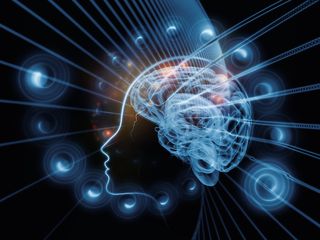Imagination and Reality Look Different in the Brain

"Turn off your mind, relax, and float down stream..."
Maybe John Lennon was onto something when he wrote those words for the Beatles' song "Tomorrow Never Knows."
It turns out that that reality and imagination flow in different directions in the brain, researchers say. The visual information from real events that the eyes see flows "up" from the brain's occipital lobe to the parietal lobe, but imagined images flow "down" from the parietal to the occipital.
"There seems to be a lot in our brains and animal brains that is directional — that neural signals move in a particular direction, then stop, and start somewhere else," said Dr. Giulio Tononi, a psychiatry professor and neuroscientist at the University of Wisconsin-Madison and one of the study's co-authors. "I think this is really a new theme that had not been explored."
The finding, published in the November issue of the journal NeuroImage, may lead to a better understanding of how the brain processes short-term memories and how memory is connected to imagination, the researchers said.
By "flow," the scientists are referring to the general direction of electrical signaling of neurons in the brain. This direction is oriented against the various lobes of the brain. [Inside the Brain: A Photo Journey Through Time]
The occipital lobe sits in the lower, back part of the brain. Containing the visual cortex, this lobe's primary function is to process visual information. The parietal lobe lies above the occipital lobe, and its primary function is to integrate sensory information, such as vision, but also touch and sound. In doing so, the parietal lobe assembles elementary building bricks from so-called "lower-order" brain regions to create concepts, said Daniela Dentico, a researcher at the University of Wisconsin-Madison and lead author on the report.
Sign up for the Live Science daily newsletter now
Get the world’s most fascinating discoveries delivered straight to your inbox.
A leading theory in image processing "posits that our visual mental images are not stored somewhere in the brain, but get actively reconstructed," Dentico told Live Science. The brain does this, she said, by reversing the order it uses for visual perception. She described this as the "top-down" direction, which starts from the big concept and moves back toward the smaller elements.
"Our study represents the first direct measure of the prevalence of top-down signal flow during imagery," Dentico added.
To determine the flow of neural firing, the Madison researchers, along with scientists at University of Liege in Belgium, asked study participants who were hooked up to an electroencephalography (EEG) machine to watch videos or to imagine fantastical scenes, such as traveling on a magic bicycle. EEG is an established technique that uses sensors on the scalp to measure underlying electrical activity.
But because the brain isn't "quiet," EEGs tend to reveal the cacophony of brain activity, said Barry Van Veen, a professor of electrical and computer engineering at Madison and senior author on the report.
So, to zero in on the flow of reality and imagination, the researchers created complex statistical modeling requiring high-throughput computing. From this, they could determine, for the first time, the average directional flow of neural firing during the tasks of seeing and imagining.
The researchers could not determine, however, whether imagination originates in the parietal lobe. It may instead flow through the parietal lobe from the frontal lobe, the brain region most associated with human intelligence. This is a topic for further investigation, the researchers said.
Follow Christopher Wanjek @wanjek for daily tweets on health and science with a humorous edge. Wanjek is the author of "Food at Work" and "Bad Medicine." His column, Bad Medicine, appears regularly on Live Science.

Christopher Wanjek is a Live Science contributor and a health and science writer. He is the author of three science books: Spacefarers (2020), Food at Work (2005) and Bad Medicine (2003). His "Food at Work" book and project, concerning workers' health, safety and productivity, was commissioned by the U.N.'s International Labor Organization. For Live Science, Christopher covers public health, nutrition and biology, and he has written extensively for The Washington Post and Sky & Telescope among others, as well as for the NASA Goddard Space Flight Center, where he was a senior writer. Christopher holds a Master of Health degree from Harvard School of Public Health and a degree in journalism from Temple University.
